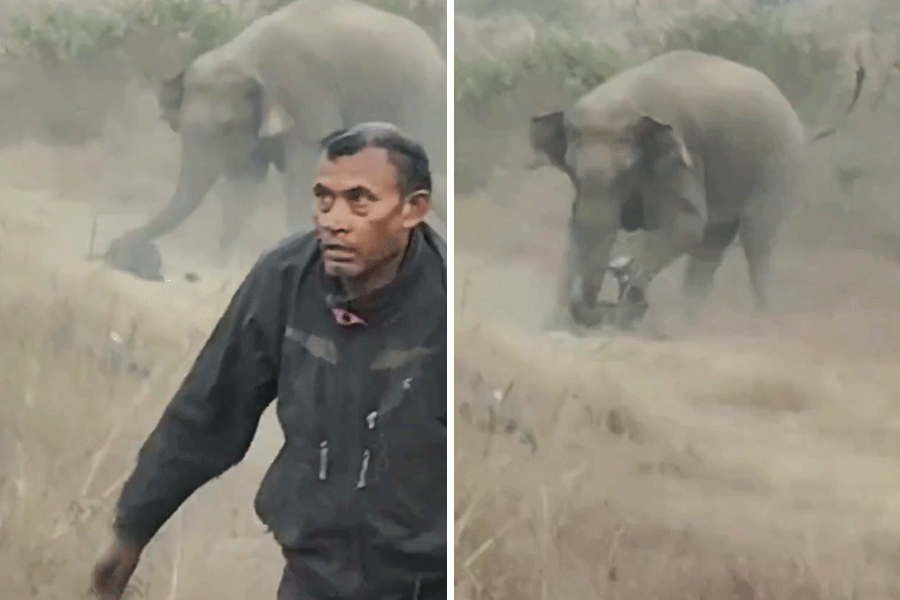 |
Aditya and Namita Pradhan lived the typical, busy corporate life. The Bangalore-based software professional couple clocked about 10 hours’ work in office, spent their evenings teleconferencing with overseas clients, lived out of suitcases as they travelled frequently and took home a seven figure salary.
What suffered, in the bargain, was their sex lives. “We always returned home tired. There was no time or inclination to get intimate,” recalls 35-year-old Namita, who works as a team leader for an information technology (IT) multinational.
But last year, when she began sensing a sexual and emotional void in her life, Namita decided to revive her sagging libido. The couple signed up for Sex Symphony — a 10-day dance therapy workshop conducted in the city by A.V. Satyanarayana.
“Dance is a sensuous art. In the workshop, we teach dance in a way that enhances touch, eye contact, and an awareness of the partner’s body. It’s mental foreplay,” explains Satyanarayana, a retired bank officer who started a dance therapy centre in Bangalore in 2000. About 1,000 people have attended the Sex Symphony workshop so far.
“Dance movements stimulate the production of sexual hormones, relax the mind and body and increase libido,” adds Satyanarayana, who also uses it to cure diabetes, obesity and stress.
Supporters of allopathic medicine may scoff, but many urban Indians are on the lookout for new, alternative cures to physical and psychological problems. And like dance therapy, a range of offbeat antidotes like reel therapy — watching movies to cure psychological problems — horticulture therapy, cow urine therapy, ozone therapy, spirit release therapy and past life regression therapy are gaining currency in the country.
G.R. Yugandhar — who started an association for alternative medical practitioners in 2007 — believes non-allopathic practices are becoming popular because modern-day diseases are more psychosomatic than physical in nature. “Most common health disorders — like hypertension, migraine, diabetes and blood pressure — are caused by bad lifestyle, stress and wrong eating habits. They can’t be cured only by popping medicines,” says the founder, New Age Doctors Association (NADA), Hyderabad.
NADA — which currently has 2,500 members — has big plans to boost the alternative healthcare industry in India. In December this year, it is organising an international meet on holistic health remedies. And in 2016, it will set up a Spiritual and Holistic Health University, in Hyderabad. “The university will run courses on 100 therapies — ranging from homeopathy and ayurveda to pranic healing and horticulture therapy,” claims Yugandhar.
Last November, students of a Bangalore college were shown two back-to-back Hindi films — Lagaan and Chak De India. It wasn’t a break from books, but a reel therapy — or motion picture prescription — session in progress. “Both films talk about teamwork, building self-esteem and motivation,” says Neha Cadabam, executive director and psychologist, Cadabam’s Mind Talk (CMT), a Bangalore-based rehabilitation centre that introduced reel therapy last year.
Watching movies can also cure depression, schizophrenia and bipolar disorders, claims Cadabam. So far, 40 schizophrenia and bipolar disorder patients have undergone reel therapy at Cadabam’s centre.
Poonam Sharma remembers her nine-year-old son, Prateek, as quite a problem child. “He was hyperactive and his teachers complained he was disruptive in class, inattentive and disinterested in studies,” remembers the Pune-based mother.
The harried parent then put Prateek under the care of Pepsi, a black Labrador, who was part of Tails of Joy — a reading programme run by Animal Angels Foundation (AAF), a Pune-based pet therapy centre.
An animal therapist got Prateek to read to Pepsi and practise writing spellings on the dog’s fur coat. “Since Prateek was reading to a dog, he didn’t feel nervous or conscious of making mistakes,” recalls Minal Kavishwar, founder president, AAF.
AAF rolled out its Tails of Joy programme in 2008. “It’s based on the concept of children reading to dogs. It helps them develop a love for reading in an environment where they don’t fear being judged,” explains Kavishwar, whose centre conducts the programme at Crossword bookstores in Pune, Mumbai and Bangalore, libraries, and seven special and regular schools in Pune.
 |
 |
| Healing tools: (From top) A Tails of Joy session; a dance workshop by A.V. Satyanarayana |
Like animals, plants can heal as well, claim horticulture therapists. Says Beela G.K., faculty member at the Kerala Agriculture University, Thiruvananthapuram, “Nurturing a plant is a de-stressing and fulfilling activity,” says the horticulture therapist, who has also introduced the therapy for special children at the Centre for Disability Studies in the city.
Sociologist G.K. Karanth believes people are increasingly seeking alternative cures in their rush to find easy solutions to physical and mental ailments. “A healthy lifestyle — comprising exercise and eating and resting right — is the best therapy. Since urban Indians don’t have the time to invest in this, they look for quick fix remedies like feng shui and ozone baths,” says the sociology professor at the Institute for Social and Economic Change, Bangalore.
Also, with lifestyle-related diseases like heart problems, blood pressure and diabetes on the rise, urban Indians are opting for alternative therapies as they seem far simpler than undergoing complex medical procedures like open heart surgeries and taking daily insulin injections.
Take the case of chelation therapy. Practitioners claim it can help heart patients bypass the bypass surgery. “Special drugs are injected intravenously to clear blocked blood vessels. It’s used to remove blockages in the brain, retina, kidney and sexual organs,” says Dhananjay Shah, a Mumbai-based chelation therapist.
Some therapies — like past life regression (PLR) and spirit release therapy — border on the paranormal. Amit Jain, a Mumbai-based chartered accountant, found it difficult to trust people. When this started affecting his relationship with his spouse, he opted for PLR therapy. “Jain regressed to a past life in the 17th century, where he was a general in the Maratha army. During battle, he was stabbed in the back by his own lieutenant,” recalls Yuvraj Kapadia, CEO, California Hypnosis Institute of India (CHII), Mumbai, who treated Jain. With his past life betrayal buried, Jain began forging better relationships, adds Kapadia.
Purists, however, dismiss these therapies as no more than pop psychology. “These days, people want immediate solutions to their problems — which traditional psychology cannot give. So single-session treatments like PLR therapy are getting popular,” says Ajit Bhide, head of department, psychiatry, St Martha’s Hospital, Bangalore.
Well as long as the recipients are happy, no one is complaining.











